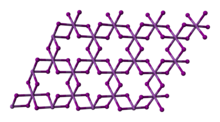Bismuth(III) iodide

| |

| |

| |

| |
| Names | |
|---|---|
| IUPAC name
Bismuth(III) iodide
| |
| Other names
Bismuth iodide, bismuth triiodide
| |
| Identifiers | |
3D model (JSmol)
|
|
| ChemSpider | |
| ECHA InfoCard | 100.029.207 |
| EC Number |
|
PubChemCID
|
|
| UNII | |
CompTox Dashboard(EPA)
|
|
| |
| |
| Properties | |
| BiI3 | |
| Molar mass | 589.69g/mol |
| Appearance | Greenish-black crystals |
| Density | 5.778g/cm3 |
| Melting point | 408.6 °C (767.5 °F; 681.8 K) |
| Boiling point | 542 °C (1,008 °F; 815 K)[2] |
| 0.7761mg/100mL (20°C) | |
Solubility product(Ksp)
|
7.71×10−19[1] |
| Solubility | 50g/100mLethanol 50g/100mL 2Mhydrochloric acid |
| −200.5·10−6cm3/mol | |
| Structure | |
| Trigonal,hR24 | |
| R-3, No. 148 | |
| Hazards | |
| GHSlabelling: | |

| |
| Danger | |
| H314 | |
| P260,P264,P280,P301+P330+P331,P303+P361+P353,P304+P340,P305+P351+P338,P310,P321,P363,P405,P501 | |
| NFPA 704(fire diamond) | |
| Related compounds | |
Otheranions
|
Bismuth(III) fluoride Bismuth(III) chloride Bismuth(III) bromide |
Othercations
|
Nitrogen triiodide Phosphorus triiodide Antimony triiodide |
Except where otherwise noted, data are given for materials in theirstandard state(at 25 °C [77 °F], 100 kPa).
| |
Bismuth(III) iodideis theinorganic compoundwith theformulaBiI3.This gray-black salt is the product of the reaction of bismuth and iodine, which once was of interest inqualitative inorganic analysis.[3][4]
Bismuth(III) iodide adopts a distinctive crystal structure, withiodidecentres occupying ahexagonally closest-packedlattice, and bismuth centres occupying either none or two-thirds of the octahedral holes (alternating by layer), therefore it is said to occupy one third of the total octahedral holes.[5][6]
Synthesis
[edit]Bismuth(III) iodide forms upon heating an intimate mixture of iodine and bismuth powder:[7][8]
- 2Bi + 3I2→ 2BiI3
BiI3can also be made by the reaction ofbismuth oxidewith aqueoushydroiodic acid:[9]
- Bi2O3(s) + 6HI(aq) → 2BiI3(s) + 3H2O(l)
Reactions
[edit]Since bismuth(III) iodide is insoluble in water, an aqueous solution can be tested for the presence of Bi3+ions by adding a source of iodide such aspotassium iodide.A blackprecipitateof bismuth(III) iodide indicates a positive test.[10]
Bismuth(III) iodide forms iodobismuth(III) anions when heated with halide donors:[11]
- 2NaI+ BiI3→ Na2[BiI5]
Bismuth(III) iodide catalyzes theMukaiyama aldol reaction.Bi(III) is also used in aBarbiertype allylation of carbonyl compounds in combination with a reducing agent such aszincormagnesium.
References
[edit]- ^John Rumble (June 18, 2018).CRC Handbook of Chemistry and Physics(99 ed.). CRC Press. pp. 5–188.ISBN978-1138561632.
- ^Norman, Nicholas C. (1998),Chemistry of Arsenic, Antimony and Bismuth,Springer, p. 95,ISBN0-7514-0389-X,retrieved2008-06-03
- ^ "Bismuth iodide",McGraw-Hill Dictionary of Scientific and Technical Terms,McGraw-Hill, 2003,retrieved2008-06-19
- ^ Turner, Jr., Francis M.; Berolzheimer, Daniel D.; Cutter, William P.; Helfrich, John (1920),The Condensed Chemical Dictionary,New York: Chemical Catalog Company, p. 107,retrieved2008-06-19
- ^ Smart, Lesley; Moore, Elaine A. (2005),Solid State Chemistry: An Introduction,CRC Press, p. 40,ISBN0-7487-7516-1,retrieved2008-06-19
- ^ Mackay, Rosemary Ann; Henderson, W. (2002),Introduction to Modern Inorganic Chemistry,CRC Press, pp. 122–6,ISBN0-7487-6420-8,retrieved2008-06-19
- ^Watt, George W.; Hakki, Wafai W.; Choppin, Gregory R. (1953). "Bismuth(III) Iodide".Inorganic Syntheses.Inorganic Syntheses.Vol. 4. pp. 114–116.doi:10.1002/9780470132357.ch38.ISBN978-0-470-13163-3.
- ^Erdmann, Hugo;Dunlap, Frederick Leavy (1900),Handbook of Basic Tables for Chemical Analysis,New York: John Wiley & Sons, p. 76,retrieved2008-06-19
- ^Greenwood, Norman N.;Earnshaw, Alan (1997).Chemistry of the Elements(2nd ed.).Butterworth-Heinemann.p. 559.ISBN978-0-08-037941-8.
- ^ Bruno, Thomas J.; Svoronos, Paris D. N. (2003),Handbook of Basic Tables for Chemical Analysis,CRC Press, p. 549,ISBN0-8493-1573-5,retrieved2008-06-19
- ^ Norman, Nicholas C. (1998),Chemistry of Arsenic, Antimony and Bismuth,Springer, pp. 168–70,ISBN0-7514-0389-X,retrieved2008-06-19

